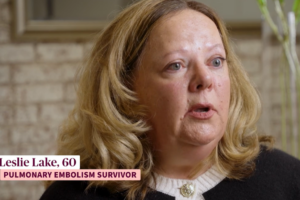Living Your Best Life While Taking Blood Thinners
Watch our our December 2024 PEP Talk on bleeding while on anticoagulants.
Don’t Let Nuisance Bleeding Worry You
More than eight million people in the United States are currently taking a blood thinner (anticoagulant) medication. The reasons for using blood thinning medications vary from person to person, but one thing is common to all people who take them: Blood thinners are lifesaving medications, but bleeding risks must be effectively managed. Fortunately, there are ways to avoid and quickly stop non-life-threatening or “nuisance” bleeding.
Blood Thinner Medications Save Lives
Blood thinning medications come in two forms – a pill that is taken by mouth, or by an injection. Both types affect the body’s ability to make clots. Blood thinners can stop clots from forming, slow down the formation of clots, stop clots from getting bigger, or prevent clots that have already formed from traveling to other parts of the body.
Blood clots do play an important role in sealing up wounds when we cut ourselves or suffer other injuries, but when blood clots form in the blood stream, they can be very dangerous. The most common reasons for a healthcare provider to prescribe a blood thinning medication include:
- A person has an irregular heartbeat and is at risk for developing a clot that can cause stroke
- A person has a blood clot in their leg that can travel to the lung
- A person has a blood clot in their lung that can prevent breathing
- A person had a serious injury or is having surgery, which can cause blood clots to form in the legs or lungs
- A person had a heart attack and is at risk to develop a clot in the heart that can travel to other parts of the body
- A person has a mechanical heart valve and is at risk to develop a clot in the heart that can travel to other parts of the body
Common Risk: Bleeding
Blood thinning medications save lives because they can treat or prevent dangerous blood clots. But they also pose one possible and very serious side effect: bleeding. Since blood thinners slow the clotting of blood, unwanted and sometimes dangerous bleeding can occur.
A person who takes blood thinners should tell their healthcare provider about any bleeding or unusual bruising, as well as any serious falls or bumps to the head. Although infrequent, bleeding caused by blood thinners can be very serious or life-threatening, like bleeding into the brain or stomach. Serious or life-threatening bleeding requires immediate medical attention.
Nuisance Bleeding
Most of the time, bleeding caused by blood thinners is not serious or life-threatening. But it can still be troublesome and inconvenient, and it can seriously impact the quality of a person’s day-to-day life. Here are some examples:
- Frequent nosebleeds, or nosebleeds that last longer than five minutes
- A small cut while shaving with a razor might bleed longer than normal, or for more than five minutes
- A minor cut, laceration, or skin tear that may bleed for a long time
While this type of nuisance bleeding is not life-threatening, more than half of all emergency room visits among people who take blood thinners are for nosebleeds and other types of nuisance bleeding caused by superficial wounds to the skin. Most importantly, nuisance bleeding is also frequently to blame when people stop taking their blood thinning medication as directed by their healthcare provider, which puts them at risk again for dangerous or life-threatening blood clots that can result in hospitalization and added healthcare costs.
How to Manage Nuisance Bleeding
People who take blood thinners can still engage in most of the activities that they enjoy, they just need to take some extra precautions. For example:
- Be cautious about activities such as high-risk sports, which may result in injury, and always wear proper safety gear
- Wear protective gloves when working with tools, such as gardening shears or other sharp instruments
- Be careful when trimming hair or nails
- Use a soft toothbrush
- Wear shoes to avoid cuts on feet
No matter how cautious a person might be, accidents can happen, and nuisance bleeding might still occur. When it does, there are several products, including special bandages, wound dressings, gels, and powders that can be used to help stop nuisance bleeding more quickly.
Special bandages or wound dressings, like BloodStop and the QuickClot clotting sponge, are applied to superficial wounds to help control bleeding until medical attention can be provided.
Products like Celox form a protective gel cover over wounds to stop bleeding. There are also powders such as WoundSeal that can be poured onto the skin or site of superficial bleeding to quickly form an instant scab. WoundSeal can also be used with a special applicator to stop nose bleeds.
Products like these are available without a prescription and can be found online or at most pharmacies. They don’t interfere with the blood’s natural clotting mechanism to be effective, so they can be used safely by people who are taking blood thinning medications.
You might also like: Blood Thinners and Food | A Few Tips
Menstrual Bleeding and Anticoagulation – What Patients Need to Know




